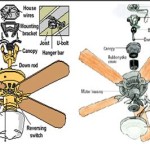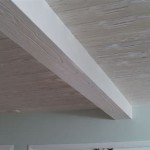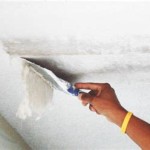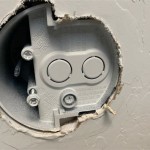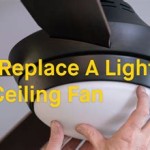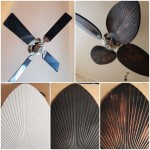Can You Put A Flush Mount Fan On A Sloped Ceiling?
Flush mount ceiling fans, also known as hugger fans, are designed to be installed close to the ceiling, making them ideal for rooms with low ceilings. However, the question of whether they can be installed on sloped or angled ceilings requires careful consideration. The short answer is generally no, but there are exceptions and specific adaptations that can make it possible in certain circumstances. Understanding the nuances of ceiling fan installation, particularly the mechanisms required for sloped ceilings, is crucial for safety and optimal performance.
Standard flush mount fans are typically designed for flat, horizontal ceilings. They lack the necessary components to compensate for the angle of a sloped ceiling, which can lead to several problems. Installing a standard flush mount fan on a slope without proper adjustments can create instability, uneven weight distribution, and potential mechanical failure. The fan blades may not operate correctly, leading to poor airflow and increased vibration, which could ultimately damage the fan and pose a safety hazard. Furthermore, the aesthetics of a flush mount fan installed improperly on a sloped ceiling can be unappealing.
The primary reason standard flush mount fans are unsuitable for sloped ceilings lies in their mounting bracket and the absence of a downrod. A downrod is a vertical extension that connects the fan motor to the mounting bracket. It allows the fan to hang freely and evenly, regardless of the ceiling's angle. Flush mount fans, by design, eliminate the downrod to minimize the overall height of the fan. This direct connection between the motor and the mounting bracket means any slope in the ceiling will directly impact the fan's balance and operation.
Understanding the Challenges of Sloped Ceiling Fan Installation
Sloped ceilings present several challenges that must be addressed to ensure a safe and functional ceiling fan installation. These challenges revolve around gravity, balance, and the fan's ability to rotate freely without obstruction. The first challenge is gravitational force. On a flat ceiling, the weight of the fan is distributed evenly across the mounting bracket. On a sloped ceiling, gravity pulls the fan downwards at an angle, creating uneven stress on the mounting bracket and potentially causing it to loosen or fail over time. This uneven weight distribution can also lead to wobbling, increased noise, and premature motor wear.
The second challenge is maintaining proper balance. Ceiling fans are designed to rotate smoothly and silently. Any imbalance can cause the fan to vibrate, which can be annoying and even dangerous. When a standard flush mount fan is installed on a sloped ceiling, the blades may not be perfectly level, leading to an imbalance. This imbalance can be exacerbated by the varying distances between the fan blades and the ceiling, which can affect airflow and create turbulence. Addressing this issue usually involves installing a sloped ceiling adapter.
The third challenge is ensuring adequate clearance between the fan blades and the ceiling. On a flat ceiling, this clearance is typically uniform. However, on a sloped ceiling, the distance between the blades and the ceiling will vary depending on the angle of the slope. If the clearance is insufficient, the blades may strike the ceiling, causing damage to both the fan and the ceiling. This is less likely to occur if the sloped ceiling fan is specially designed.
Sloped Ceiling Adapters: A Solution for Angled Ceilings
Fortunately, there are solutions that allow ceiling fans to be safely and effectively installed on sloped ceilings. The most common solution is using a sloped ceiling adapter. A sloped ceiling adapter is a specialized mounting bracket designed to compensate for the angle of the ceiling. These adapters typically consist of a ball-and-socket joint that allows the fan to hang vertically, regardless of the ceiling's slope. The adapter is attached to the ceiling, and the downrod of the ceiling fan is then connected to the adapter.
The angle of the slope determines the type of adapter required. Adapters are typically rated for specific slope ranges, such as up to 30 degrees or up to 45 degrees. It is crucial to select an adapter that is appropriate for the slope of the ceiling to ensure a secure and stable installation. Using an adapter that is not rated for the angle of the slope can compromise the integrity of the installation and pose a safety risk. An angle finder or protractor may be used to measure the exact slope of the ceiling.
Installing a sloped ceiling adapter is generally more complex than installing a standard mounting bracket. It often requires additional tools and expertise. It is essential to follow the manufacturer's instructions carefully and to ensure that the adapter is securely attached to the ceiling joist. If unsure, consulting a professional electrician or handyman is highly recommended.
When selecting a sloped ceiling adapter, it is important to consider the weight capacity of the adapter and the weight of the ceiling fan. The adapter must be able to support the weight of the fan without buckling or failing. It is also important to choose an adapter that is compatible with the ceiling fan being installed. Some adapters are designed for specific types of ceiling fans, while others are more universal.
Modified Flush Mount Fans: Addressing Specific Scenarios
While standard flush mount fans are generally not suitable for sloped ceilings, some manufacturers offer modified flush mount fans that are specifically designed for angled installations. These fans incorporate design elements that allow them to be installed on sloped ceilings without the need for a separate adapter. However, these modifications are generally for ceilings with a very slight slope. These design elements include a specialized mounting bracket with a built-in leveling mechanism and a low-profile design that minimizes the visual impact of the slope. In these modified designs, a very short downrod is often integrated.
These modified flush mount fans are typically suitable for ceilings with a slope of less than 15 degrees. They are not recommended for steeper slopes, as they may not provide adequate stability or balance. Before purchasing a modified flush mount fan for a sloped ceiling, it is important to carefully review the manufacturer's specifications and to ensure that the fan is rated for the angle of the slope.
The installation process for a modified flush mount fan may differ from that of a standard flush mount fan. It is essential to follow the manufacturer's instructions carefully and to ensure that all components are properly installed and secured. If unsure, consulting a professional electrician or handyman is recommended. In some cases, modifying a standard flush mount fan yourself for a sloped ceiling is possible, but this is not recommended due to the potential safety hazards. Modifying electrical equipment without proper expertise can lead to electrical shock, fire, or other serious injuries.
Ultimately, the decision of whether to install a flush mount fan on a sloped ceiling depends on several factors, including the angle of the slope, the design of the fan, and the availability of appropriate adapters or modifications. The key is to prioritize safety and to ensure that the fan is installed correctly and securely. Improper installation can lead to a variety of problems, including instability, noise, poor airflow, and potential safety hazards.

How To Install A Ceiling Fan On Sloped Lemon Thistle

How To Choose A Ceiling Fan For Vaulted Ceilings Lightology

How To Install A Ceiling Fan On Sloped Lemon Thistle

Install Ceiling Fan On Sloped Simple Modern Handmade Home

Vaulted Sloped Ceiling Adapter For Modern Fan Company Fans Stardust

Electrical Mount Ceiling Fan At The Peak Of A Sloped Home Improvement Stack Exchange

Fans On An Angle Installing Ceiling Angled Or Raked
How To Install A Ceiling Fan On Vaulted Quora

Ceiling Fan Size Guide What Should I Consider

Surface Mounting To Angled Ceilings General Q A Chieftalk Forum
Related Posts

